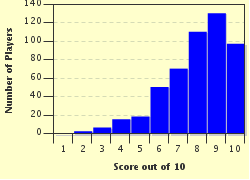Quiz Answer Key and Fun Facts
1. On 25 September 1066, King Harold II was victorious at the battle of Stamford Bridge. What happened next when he marched with his army to face the invading forces led by William of Normandy?
2. The death of a prominent cleric was the direct result of a rash statement made by King Henry II in 1170. Who was the victim of the fatal words, popularly quoted as "will no one rid me of this turbulent priest?"?
3. The unpopular 'third poll tax' levied by parliament to pay for England's war against France was a direct cause of which event of 1381?
4. In 1483, the disappearance of the 'Princes in the Tower' resulted in their uncle King Richard III being suspected of their murders. However, there were further repercussions in 1497 when a man claiming to be one of the missing princes led the Second Cornish Uprising and had himself declared 'King Richard IV' on Bodmin Moor. What was the name of this pretender to the throne?
5. The Great Fire of London in 1666 destroyed large parts of the city, including St Paul's Cathedral. To which famous architect did the fire grant the opportunity to design a replacement building for St Paul's?
6. Under the terms of the Acts of Union, England and Scotland merged to form Great Britain in 1707. However, the two countries had already shared a monarch for over a hundred years since which monarch of Scotland also became monarch of England?
7. A 1731 incident, in which the captain of a British merchant ship lost an ear, later became the inspiration for the name of a war which took place from 1739 to 1748. Which European nation did Britain fight against in the 'War of Jenkins' Ear'?
8. Admiral Lord Nelson, commander of the British fleet, was shot and killed at the Battle of Trafalgar on 21 October 1805. How did the Royal Navy deal with his body directly after the battle?
9. The Emperor of France, Napoleon Bonaparte, escaped from exile on the island of Elba in February 1815. At which battle, the inspiration for the winning entry of the 1974 Eurovision Song Contest, was Napoleon finally defeated?
10. The 1926 General Strike was called in support of which group of industrial workers, who had faced increased working hours for reduced pay since the start of the decade?
Source: Author
Fifiona81
This quiz was reviewed by FunTrivia editor
bloomsby before going online.
Any errors found in FunTrivia content are routinely corrected through our feedback system.

